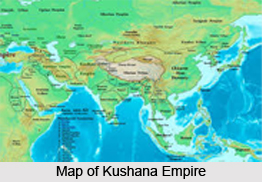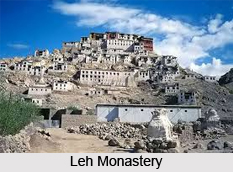 Buddhism in Jammu and Kashmir had acquired quite a stronghold in its early days. It found its way into Kashmir about a century and a half after the Parinirvana of Lord Buddha. It is fact that Jesus Chirst came to India to learn Buddhist philosophy. But though the faith was prevalent in the Valley in the time of the native ruler Surendra, who ruled a few decades before Ashoka, yet, it was in the time of the renowned Mauryan emperor (273-236 B. C.) that the faith spread widely. Ashoka is known to have visited the Valley personally also when he erected a number of Chaityas and Stupas, in Srinagar and other localities.
Buddhism in Jammu and Kashmir had acquired quite a stronghold in its early days. It found its way into Kashmir about a century and a half after the Parinirvana of Lord Buddha. It is fact that Jesus Chirst came to India to learn Buddhist philosophy. But though the faith was prevalent in the Valley in the time of the native ruler Surendra, who ruled a few decades before Ashoka, yet, it was in the time of the renowned Mauryan emperor (273-236 B. C.) that the faith spread widely. Ashoka is known to have visited the Valley personally also when he erected a number of Chaityas and Stupas, in Srinagar and other localities.
Golden Age of Buddhism in Kashmir
Buddhism witnessed its Golden Age in Kashmir during the time of the Kushana Empire who ruled during the first and second centuries of the Christian era. The Kushana rulers covered the Valley with the Monastaries, Chaityas and other Buddhist foundations. Their generous patronage of the faith gave it a great boost and helped in strengthening it in the Valley.
Fourth Buddhist Council in Kashmir
The Fourth Buddhist Council convoked by Kanishka, the greatest of the Kushana rulers, was held in Kashmir. This fact is attested by Hieun Tsang, and by Tibetan monks Bu Ston and Tarantha. According to them, the Council which was called to reconcile the different interpretations of the faith by the various sects, was attended by 500 Arhats, 500 Bodhisattvas and 500 pundits.  The holding of the Council conferred great prestige on Kashmir as a seat of Buddhist leaning so much so that eminent Buddhist monks from other parts of India and Central Asia, China and Tibet continued to visit it long after the pious labours of the Council had concluded. The illustrious Buddhist philosopher, Nagarjuna was in Kashmir in the time of the later Kushanas. Under his guidance, the Buddhists defeated in disputation all the learned Brahmins in the land which, according to Kashmiri`s native historian, Kalhana, was then "for the most part an appendage of the Buddhists who had acquired lustre by renunciation." As the faith embraced almost all the people in the Valley, the traditional rites and customs fell into disuse.
The holding of the Council conferred great prestige on Kashmir as a seat of Buddhist leaning so much so that eminent Buddhist monks from other parts of India and Central Asia, China and Tibet continued to visit it long after the pious labours of the Council had concluded. The illustrious Buddhist philosopher, Nagarjuna was in Kashmir in the time of the later Kushanas. Under his guidance, the Buddhists defeated in disputation all the learned Brahmins in the land which, according to Kashmiri`s native historian, Kalhana, was then "for the most part an appendage of the Buddhists who had acquired lustre by renunciation." As the faith embraced almost all the people in the Valley, the traditional rites and customs fell into disuse.
Decline of Buddhism in Kashmir
Buddhism suffered a decline at the end of the Kushana rule. In the medieval era, the Buddhism was declined with the Islamic attacks in India. The Kashmir Valley which enjoys a world-wide reputation on account of its scenic beauty and healthy climate in summer, is a very cold place in winter lost its tranquillity in 10th Century. The winters were especially severe in olden days. In the years immediately following the loss of the Kushanas, there were very heavy snowfalls for a number of winters in succession so much so that the ruler and his courtiers too were compelled to spend their winter outside the valley proper. The excessive snowfalls and the severity of the cold weather resulted in the death of large numbers of people. The Brahmins ascribed this natural calamity to the wrath of the Naga deities for the stoppage of the customary offerings to them under the influence of the Buddhist monks. This led to a revival of the former mode of worship.
Impact of Buddhism in Kashmir
A clear idea of the great impact that Buddhism had made on the people of Kashmir in Kushana times is available from the fact that when, following, them, the traditional mode of worship was restored, the Lord Buddha was accorded a prominent place in the Hindu pantheon. Worship of the Buddha is enjoined upon the Hindus of Kashmir in the Nilamatapuranam, especially on the auspicious occasion of his birthday. On this thrice-blessed day the Buddha`s image was installed in Chaityas and temples and after bathing it in scented water worship was then offered in accordance with Buddhist practice. 
Buddha Jayanti festival in Kashmir
The Buddha Jayanti festival which commemorated the birth, enlightenment and Mahaparinirvana of Buddha, was an occasion of great joy and festivity for the people. The walls of temples and Chaityas were decorated with paintings and there was dancing and singing. Scenes from the Sakyamuni`s life are also likely to have been enacted on the occasion. Gifts of food clothes, cows, books etc, were made to the monks.
Buddhism in 15th Century
Though Buddhism ceased to be an active faith in Kashmir proper by about the end of the fifteenth century A.D., yet its impress on the people of the Valley is discernable to this day. Buddhist influence on Kashmiris is available in relic worship and widespread use of charms and amulets by Hindus and Muslims alike. The enlightened philosophy of the Buddha has not been without its impact on them. It is not unlikely that the Astamivrata, the fast observed by a large numbers of Kashmiri Hindus on the eighth day of the bright (lunar) half of the month even today, had a Buddhist origin. In fact at present also, when an Ashtami falls on Wednesday, it is called Budha Ashtami. And even now some Muslims in different parts of the Valley abstain from meat on the anniversaries of some of their sages and saints known as rishis. The `Order of the Rishis` is, by some, regarded as direct descendant of the Buddhist Sanghas. These rishis also do not marry and devote themselves to piety and meditation. The junior ones in the order go about like the Buddhist beggars collecting alms.
Buddhist Influence in Kashmiri Art and Architecture
The Buddhist influence on the art and architecture of Kashmir has been considerable. Last but not least, strong Buddhist influence on the people of the Kashmir many be seen in the qualities of tolerance, fellow feeling, compassion and charity that still form the distinguishing features of the character of a Kashmiri.



















